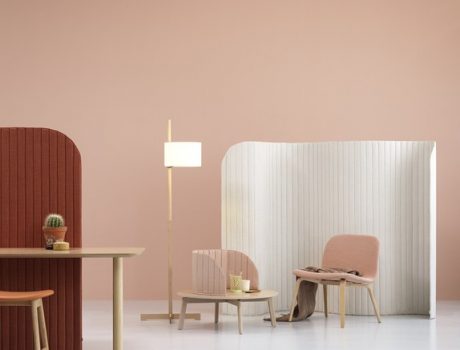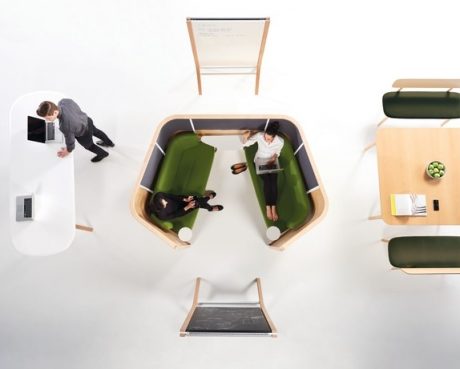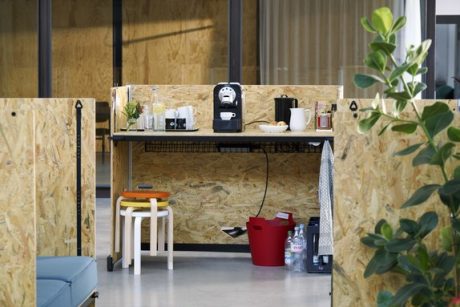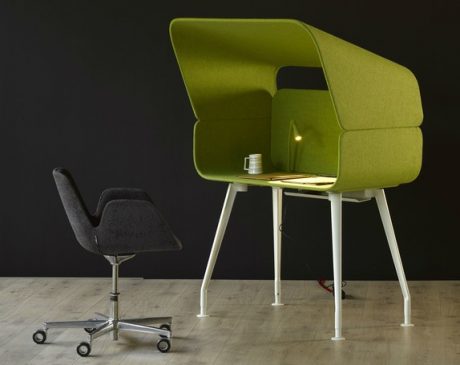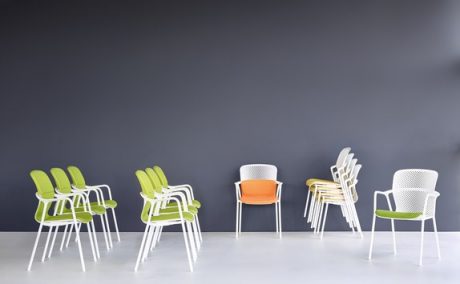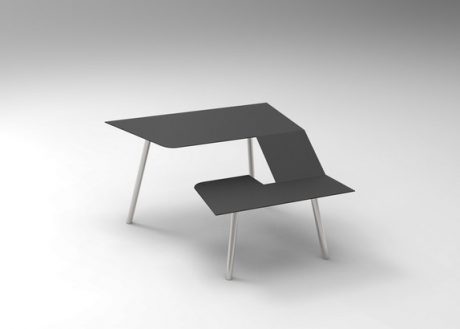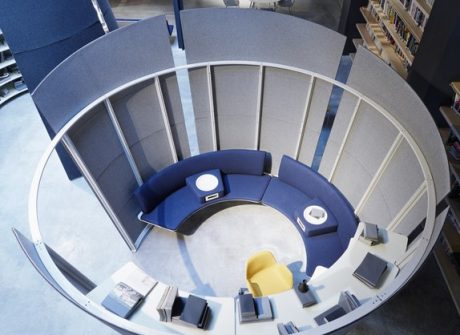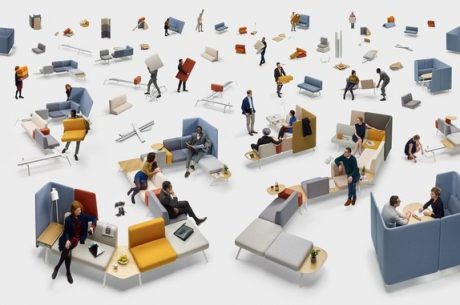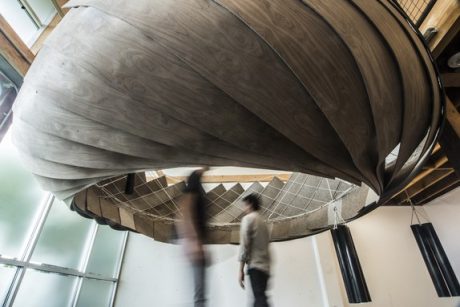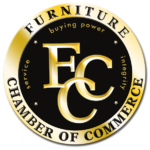Weird Furniture
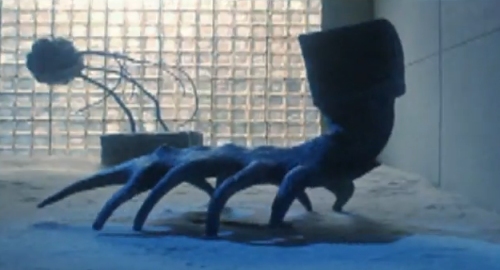
9 Pieces of Weird Furniture That’ll Cure the Dullest of Offices
By: MARGARET RHODES Original PUBLICATION Date 10.03.16 from Wired.com
THE FIRST TRULY experimental office furniture came out of Herman Miller, in 1964. The Action Office I, as it was called, comprised three adaptable upholstered walls, a swivel chair and stool, and a writing desk. At that time, most offices were filled with rows of clunky desks and drawers. The semi-enclosed Action Office was different, and embodied the ideas of its creator, designer Robert Propst, who believed individual workers needed dynamic, personal environments to feel inspired and be productive.
Propst’s well-intentioned furniture series had some major unintended consequences. Executives hated it at first. The second iteration of the Action Office eventually found commercial success, but that rapid adoption also spawned a wave of less sophisticated imitations. Propst had designed the Action Office series to set workers free. In the end, those workers wound up trapped in rigid, dreary cubicle farms.
But Propst’s high minded ideals haven’t gone away. Designers still maintain that considered office spaces can make for happier, more productive employees. Listed here are nine of the most recent, and promising, workspace solutions.
1
Focus, from Note Studio
Focus, from Note Studio The idea behind Focus is simple: Whether you’re in an office or a coffee shop, you often have to work with people hovering over your shoulder. That’s distracting—visually and aurally. Prop up Focus, a cloth-covered space divider that folds up like a paper fan, and block it all out. Swedish office design studio ZilenZio, whose tagline is “Selling silence,” designed the dividers. An added bonus: ZilenZio claims the wool on its screens is especially sound-absorbent, and even has its own in-house acoustic workshop to test products against different decibel levels.
2
Zones, from Teknion
Zones, from Teknion Teknion recently won the prize for best design at the NeoCon design expo for its open-office furniture collection. Called Zones, the system includes a diverse range of chairs, stools, and benches. It also has an easel for brainstorming, and, perhaps most notably, a couch pod where workers can either huddle for meetings or seek respite from office noise. Together, these Scandinavian-style pieces present an alternative to the standard open-office template, which typically consists of lots of desks and a few conference rooms. Zones eschews both in favor of more nuanced forms of interaction.
3
Hack, from Vitra
Hack, from Vitra For the recent London Design Fair, Vitra partnered with renowned industrial designer Konstantin Grcic to develop Hack. The name fits; the desk looks like a few sheets of composite wood, stapled together, doing an impression of a cubicle. But the system is more considered than it looks Hack folds up and packs flat, making it easy for office managers to move desks around to accommodate new hires or structural changes. Plus, each desk comes with a manually operated height-adjustment feature.
4
Cap, from Koleksiyon
Cap, from Koleksiyon Cap is a single-person desk that brings to mind those laminated paper dividers you used in elementary school, to keep cheaters from looking at your test. Only it’s a full-on upholstered workstation with outlets, built-in lighting, and concealed wiring for electronic devices. Studio Kairos, a pair of Greek designers, created it for furniture brand Koleksiyon. Plenty of modern offices are designed to create friction and interaction with coworkers; Cap is more about focus. Blocking off the user’s peripheral vision helps make that happen.
5
Keyn, from Herman Miller
Keyn, from Herman Miller At first glance, Keyn looks like a fairly standard task chair. But it’s simple looks belie its experimental, ergonomic purpose. The Keyn chair, from Herman Miller, is designed for fidgeters. London design studio Forpeople calls fidgeting a symptom of “Boring Meeting Syndrome,” and thinks this chair might help. If you’re stuck in a long meeting and can’t stop shifting around, the polymer cradle of the Keyn flexes and adapts to any posture—upright, leaning back, hunched over, whatever.
6
The Last Writing Desk,
by Frans Willigers
The Last Writing Desk, by Frans Willigers If you showed up for your first day of work, and someone from HR escorted you to The Last Writing Desk, you probably wouldn’t know what to do. Where do you sit? What goes where? Is it some kind of test? Dutch designer Frans Willigers created The Last Writing Desk with today’s technology in mind. When your only tool is your laptop, he reasons, storage space is unnecessary. You have minimal needs: a place to sit, and a place to type. The desk is equally minimal. It’s three planes of metal on top of four stainless legs.
7
Oblivion, from Koleksiyon
Oblivion, from Koleksiyon If the Oblivion work pod looks familiar, perhaps you’re thinking of the Parks and Recreation episode where a managerial shake up lands Ron in this circular desk from hell. Oblivion offers more privacy than that desk, and looks more comfortable. The design is also highly adaptable. The floor diameter, top diameter, and height of each conical pod is built to spec, as are the interior shelving, seating, and storage options.
8
Corals, from Palau
Corals, from Palau Every element of the Corals system, designed by Dutch designer Robert Bronwasser for Dutch furniture company Palau, connects together via an aluminum frame. It’s designed to be almost endlessly reconfigurable, so each of the seats, walls, tables, and armrests can affix into the aluminum base to create a private nook, or, say, a small meeting zone. That aluminum is lightweight enough that office workers can actually do the reconfiguring themselves, on the fly. And because Corals is a modular system, general maintenance should cost and waste less. If a cushion gets stained or torn, the whole couch doesn’t need to get replaced.
9
Transformable
Meeting Spaces,
from MIT and Google
Transformable Meeting Spaces, from MIT and Google MIT’s Self-Assembly Lab teamed up with Google to create this shape-shifting conference room. The structure, which looks like a piece of set design from The Swiss Family Robinson, aims to offer a middle ground between noisy, open floor plans and cloistered, private offices. It expands and contracts via a manual pulley system. Pull it down, and have a meeting. Wind it up back, and clear the floor for office happy hour. It’s not technically self-assembling, like some of the other projects that Skylar Tibbits, head of the Self-Assembly Lab, works on. But it’s certainly flexible, adapts easily to an office’s ever-changing needs.













